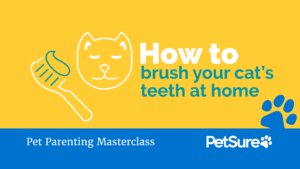We all know that cats are born with sharp claws that can make even the toughest furniture tremble. But fear not brave cat parents, in this meowgnificent video, we’ll unveil the secrets to trimming your cat’s nails like a purr-fessional, all while keeping the fun and playfulness intact.
Picture this: no more accidental scratches during playtime, no more shredded curtains and no more impressive acrobatics on your couch. Instead, picture perfectly manicured paws that are ready for cuddles, gentle pats and those epic scratching sessions on the right surfaces. Trust us, your cat will thank you for it!
So, grab your clippers and get ready to learn the tricks of the trade. Discover the right techniques and ensure an easier nail trimming experience for both you and your feline companion.
Regular nail trimming helps prevent overgrowth, reduces the risk of painful ingrown nails, minimises scratches on furniture and family members, and promotes overall paw health.
The frequency of nail trimming depends on your cat’s lifestyle and individual nail growth. On average, trimming every 2-4 weeks is a good starting point, but monitor your cat’s nails and trim as needed.
Start by getting your cat accustomed to having their paws touched. Gradually introduce them to the sight and sound of nail clippers. Make it a positive experience with treats, praise, and short sessions to build trust.
There are different types of nail clippers available, including guillotine clippers and scissor-style clippers. Choose one that you feel comfortable using and that suits your cat’s nail size. In the video we used human clippers as our vets want to show how different types of clippers can be used. If you are unsure, consult with your veterinarian.
Trim only the sharp, translucent tip of the nail known as the “hook.” Avoid cutting too close to the pink area, called the “quick,” as it contains nerves and blood vessels and can cause bleeding and discomfort.
If you accidentally cut the quick and bleeding occurs, remain calm. Apply gentle pressure with a clean, damp cloth to stop the bleeding. Alternatively, if you have a bar of hand soap in the bathroom, you can pick a small portion off, and pack it into the bleeding claw to provide pressure that will help with the bleeding. If bleeding persists or if you are unsure, consult your veterinarian.
Take it slow and be patient. Gradually desensitise your cat to the process by pairing nail trimming sessions with positive experiences like treats or playtime. Consider seeking help from a professional groomer or veterinarian if needed.
Scratching posts can help cats naturally wear down their nails. However, they may still require regular trimming, especially for indoor cats or those with excessive nail growth.
Black nails make it challenging to see the quick. Trim small, gradual sections of the nail, being cautious not to cut too deep. If uncertain, consult your veterinarian or a professional groomer for guidance.
Remember, if you have specific concerns or questions about cutting your cat’s nails, it’s best to consult your veterinarian or a professional groomer. They can provide personalised advice and demonstrate proper techniques for your cat’s specific needs.
Pet insurance can help by covering a portion of the eligible vet bill if the unexpected happens. Because it is difficult to predict the costs of veterinary care, it can help to have measures in place to help prepare for the unexpected. Check out our partner network and explore our policy tools to find a pet insurance policy.
Not all conditions or items are covered by Pet Insurance. Refer to the applicable Product Disclosure Statement for information about coverage and exclusions.



 Fact checked
Fact checked




